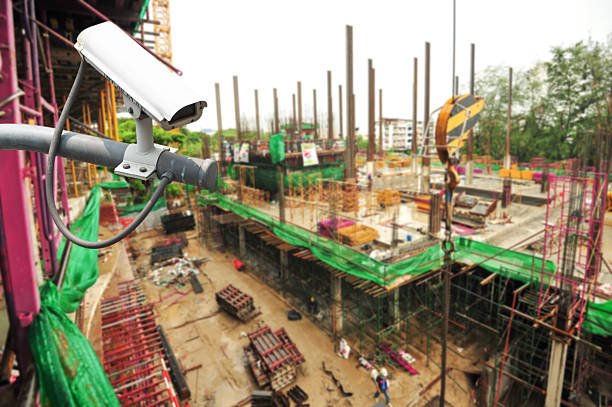
Construction projects are becoming more complex, while the timeframes to complete them are shortening. Despite the many precautions that are typically taken during the planning and execution of a construction project, risks will always exist. These threats have the potential to compromise a project’s schedule, budget, or safety. While some risks may be unavoidable, it is important to understand and manage them as best you can.
With site monitoring through construction cameras, there is the availability of visual data which can be used as a reference for risk mitigation. Risks come with the need for insurance and insurance companies are increasingly focusing on construction technology and how the solutions impact project risk and lower insurance premiums. Risk insurance costs typically range between 1% and 4% of the total construction costs, or around $1,000 to $4,000 per $100,000 of construction costs depending on the project details.
Construction is always based on a contract and there are different types of contracts for the project owners to choose from. Many of these construction contracts are flexible in payment options. In other words, the total project cost will depend upon the contractor or the construction manager. There is a possibility the project owner will lose money if the construction company doesn’t abide by the contract. Therefore, a cost risk analysis is a must-do procedure.
Construction projects involve numerous steps and calls for specialists from various fields. Subcontractors with a range of specialities are therefore crucial to the success of the construction project. However, some of the subcontractors might not be trustworthy. Additionally, they can give up on the project or do it poorly, lowering the building’s quality. For either party, defaulting is not preferred. There will be job losses for the subcontractors. Additionally, the general contractor will be responsible for any losses brought on by delays and subpar workmanship.
One of the risks a building contractor will likely encounter is changes in orders. A change order is a written document that is used to make changes to the scope of work or contract terms in a construction project. Change orders are typically used when the owner of the project requests a change to the original plans or specifications, or when unforeseen circumstances arise that require a change to the scope of work.
Change orders can be used to add, delete, or modify the work specified in the original contract. Change orders have the potential to increase project costs, push back deadlines, result in interrupted and imperfect work, and even result in unfinished projects.
With construction work comes a unique set of environmental risks and hazards, from relentless rain to earthquakes. It is essential for project teams to thoroughly plan the entire process so that most tasks are completed in ideal conditions – but even then natural disasters can put progress on hold. Having an effective risk management strategy prepared beforehand helps keep projects safe amid harsh weather changes or seismic activity.
Contractors manage risk in various ways during a project, but some of these activities are more difficult than others. This is why taking out insurance covers for projects is so important to contractors. One key way to mitigate and reduce risks or even lower insurance premiums is by adopting the use of technology and digital documentation in construction workflows.

Technology not only helps to create more accurate documentation of incidents, but it can also support trending and analysis of this data if captured in a consistent, structured manner. Visual data derived from reality capture can be used in cases where the owner would be trying to prove negligence and the GC or subcontractor tries to prove otherwise or lie.
Contract compliance can also be guaranteed through connected construction software that connects the office and field workers. With construction cameras that have the relevant software integrations, team collaboration and information sharing become easier and guarantees that rework and coordination issues are far less likely to occur.
Overall, choosing the proper solution can lower project expenses and guarantee each project’s successful conclusion. If GC is late on the substantial completion date, then the owner can hold GC liable for liquidated damages, having visual data on file, with which reference can be easily made.
The cost of liquidated damages varies from project to project due to the complexities of every project and can cost up to $1m a day. This is why setting up the right technology tools is key in order to easily compare the intended work schedule vs the actual progress of the project and to advise the owner accordingly should there be lateness
Environmental insurance is a type of insurance that provides coverage in the event of an environmental incident. This type of insurance can protect against losses resulting from the disposal of hazardous waste or the handling of hazardous materials that result in pollution. Environmental insurance can help cover the costs associated with cleanup and remediation, as well as any legal fees or damages that may be incurred as a result of the incident. It can provide peace of mind for individuals and businesses that are concerned about the potential risks of working with hazardous materials or waste.
Construction workers continue to experience high rates of fatal and nonfatal injuries and accidents despite improved safety equipment, technology, and training. When it comes to injuries caused by a failure to follow OSHA requirements, construction cameras offer video evidence.
As long as the relevant authorities are able to respond and react in time, fatal injuries can be avoided. On-site safety can become a culture thanks to cameras. When workers are being watched, they are more likely to take safeguards. Your staff can relax knowing that they are being watched over and are consequently safeguarded against any accidents with a well-equipped camera installation.
Risk is a reality in any construction project, but that doesn’t mean it has to be a roadblock to the success of any project. By understanding and proactively managing construction risks, one can safeguard projects against potential threats and keep them on track for success.
While no solution can fully eliminate project risks, for most construction companies, digital reporting helps prevent litigation significantly better than traditional reporting methods. In addition to risk mitigation, digital reporting saves time and money by giving stakeholders a highly accurate view of day-to-day progress and productivity.
Book a demo with us today to learn more about the impact we can have on your business.

Global Business Development Director